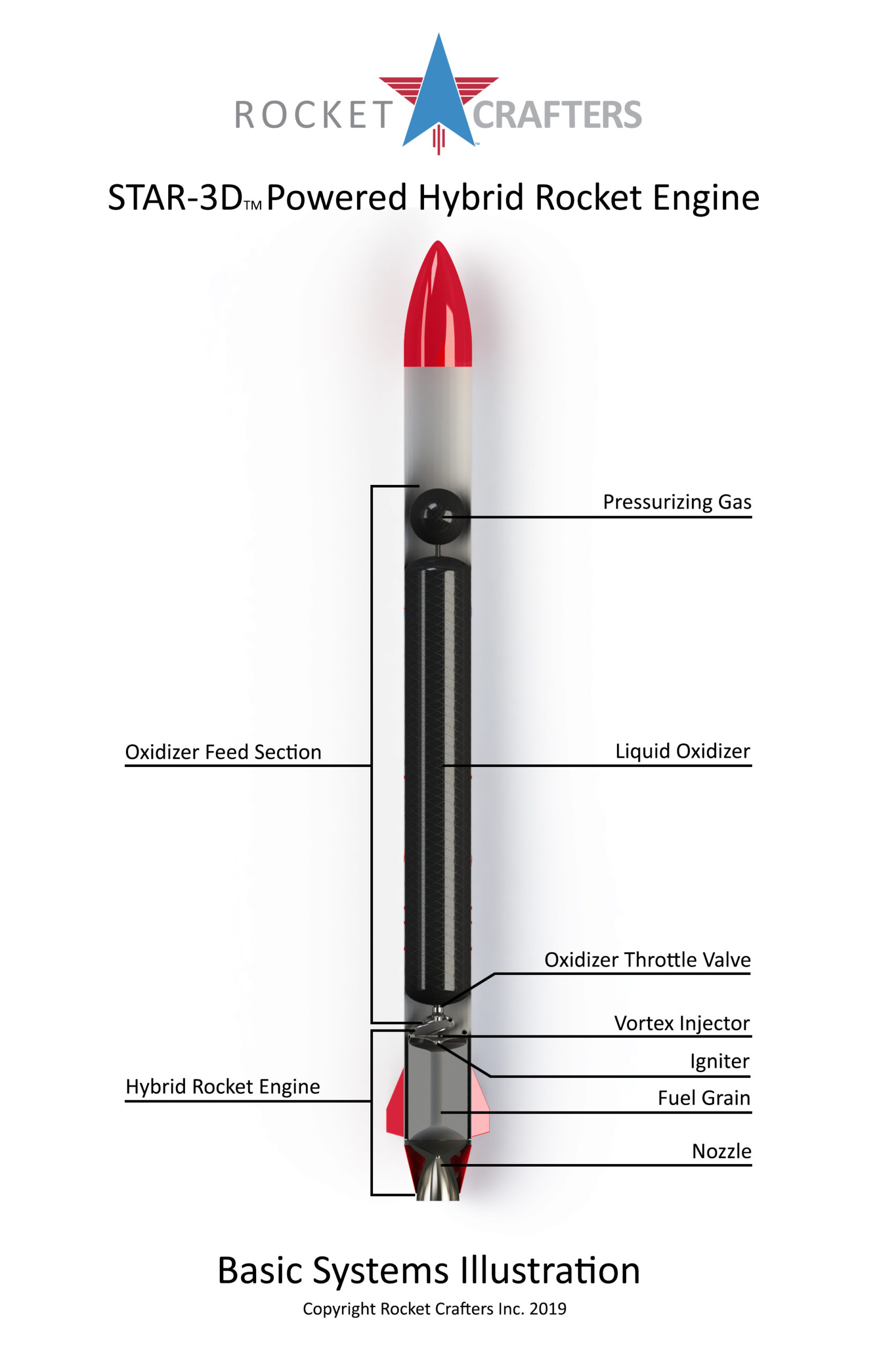After 49 successful lab tests, Florida-based private space company Rocket Crafters initiated testing of a prototype model of its STAR-3D hybrid rocket engine in February. The patent-pending, 5000-pound thrust Comet engine was tested three times to prove it could be scaled from the laboratory to a more commercially relevant size. With testing complete, the company is now preparing for the inaugural launch of the first suborbital test flight of a launch vehicle that will use 3D-printed fuel, as the first opportunity to see the performance in motion rather than just bolted to a test stand.
While the first two tests were successful, closely matching the performance models that Rocket Crafters created, the third test experienced an overpressure anomaly, resulting in damage to the test stand and test engine. The not-so-successful third test was apparently cause for concern after the company’s rocket engine sent debris through the roof and onto neighboring property. It was not an explosion, however. At the time, Orlando’s News 6 reported that startled neighbors of the city of Cocoa called firefighters that immediately responded to put out small brush fires and debris.
Going to space is hard, and preparing and building for that is even harder. Many rockets and rocket engine prototypes burst during testing. Failure is a big part of rocket science, and the engineering behind it is all about testing, failing, learning, and rebuilding. That is exactly what Rocket Crafters is doing. In fact, after the anomaly, the engineering team dug deep into the hardware and recorded data to determine what had occurred and how to prevent it in future tests.
After extensive analysis, they concluded that there was an initial failure in an ancillary part of the engine, which led to a larger over-pressurization inside the combustion chamber. Fortunately, the team found no problems within the core STAR-3D engine design, and company officials stated that it was still considered successful in terms of research and development.
“This is why we test,” said Robert Fabian, president of Rocket Crafters and a twenty-five-year veteran of military space and missile operations and maintenance. “We find and fix problems in testing, so we don’t have them on the launch pad. We’re moving forward from here.”
With the completion of the large-scale proof of concept testing, Rocket Crafters is taking its lessons learned and applying them to its next big project, slated to happen by the end of this year: a test flight powered by a smaller version of the STAR-3D hybrid rocket engine. This will be Rocket Crafters’ inaugural launch of a flight engine. Rocket Crafters has planned two more consecutively larger test flights into space and back to Earth, and then into orbit. Not long after that, commercial service to low Earth orbit (LEO) with the Intrepid small satellite launch vehicle will begin.
Expected to deliver payloads weighing about 500 kilograms into LEO, the Intrepid-1 will be the first in a family of ‘launch on-demand’ hybrid rocket-powered launch vehicles designed to send small satellites and spacecraft to orbit. Expected to launch from Cape Canaveral Air Force Station in the future, the cost of each mission has been tentatively estimated at nine million dollars.
As part of the incredibly diverse and thriving aerospace industry around Florida’s Cape Canaveral Spaceport, Rocket Crafters has been focusing on producing rocket engines and pioneering its 3D-printed rocket fuel. The company is producing plastic fuel grains using a patent-pending, horizontal 3D printing method which reduces production time for orbital-class fuel grains to a matter of hours in a single section. This means that developing and manufacturing new engines of almost any size and scale will be done in weeks instead of the years required for the more complicated Liquid Bi-propellent Engines or more dangerous Solid Rocket Motors.
Rocket Crafters claims that printing the plastic fuel core of the engine makes it more reliable, safer and smoother burning than other solid fuels, as it eliminates the risk of accidental detonation found in both solid and liquid rocket engines.
Actually, the hybrid rocket engine uses a combination of solid and liquid or gas fuel. Hybrid engines have several advantages over their strictly solid or strictly liquid counterparts. Solid rockets cannot be throttled and restarted, while hybrid rockets can, and hybrids are also faster and less expensive to develop than liquid rocket engines, thanks to their mechanical simplicity; Rocket Crafters’ rockets have only two moving parts. They’re also safer to handle than either liquid or solid rocket engines because storing the fuel in two different states safeguards against accidental detonation.
Many companies have been using 3D printing to make spacecraft manufacturing more cost-effective and safer. With so much activity going on at Rocket Crafters and a very unique rocket engine design, the company is hoping to tap into the emerging industry of private launch services to space, revolutionizing access and availability for the small satellite market.
Subscribe to Our Email Newsletter
Stay up-to-date on all the latest news from the 3D printing industry and receive information and offers from third party vendors.
Print Services
Upload your 3D Models and get them printed quickly and efficiently.
You May Also Like
How 3D Printing is Making the World a Better Place, One Medical Innovation at a Time
One of the most significant sectors for 3D printing applications is the healthcare field. According to an AM Research report, the 3D printed medical device market is estimated to reach...
3D Printing News Briefs, December 24, 2025: Investment, Acoustic Guitar, Toys for Tots, & More
In this Christmas Eve edition of 3D Printing News Briefs, we’re sharing joy and good news, starting with Nanoscribe’s exciting machine milestone! Moving on, New York’s governor is investing $32...
Velo3D’s $32.6M Defense Contract Highlights Why U.S.-Made 3D Printing Is Suddenly Critical
When the U.S. government talks about supply chain security, it’s no longer theoretical. It’s now written directly into law and into defense contracts. That detail matters for Velo3D, which this...
3D Printing Used to Make Prototype Plasma Camera Measuring Charged Particles in Space
Space is a vacuum, we’ve all heard that before. But that doesn’t mean it’s completely empty, just that it has an extremely low amount of particles and matter. Stars emit...































